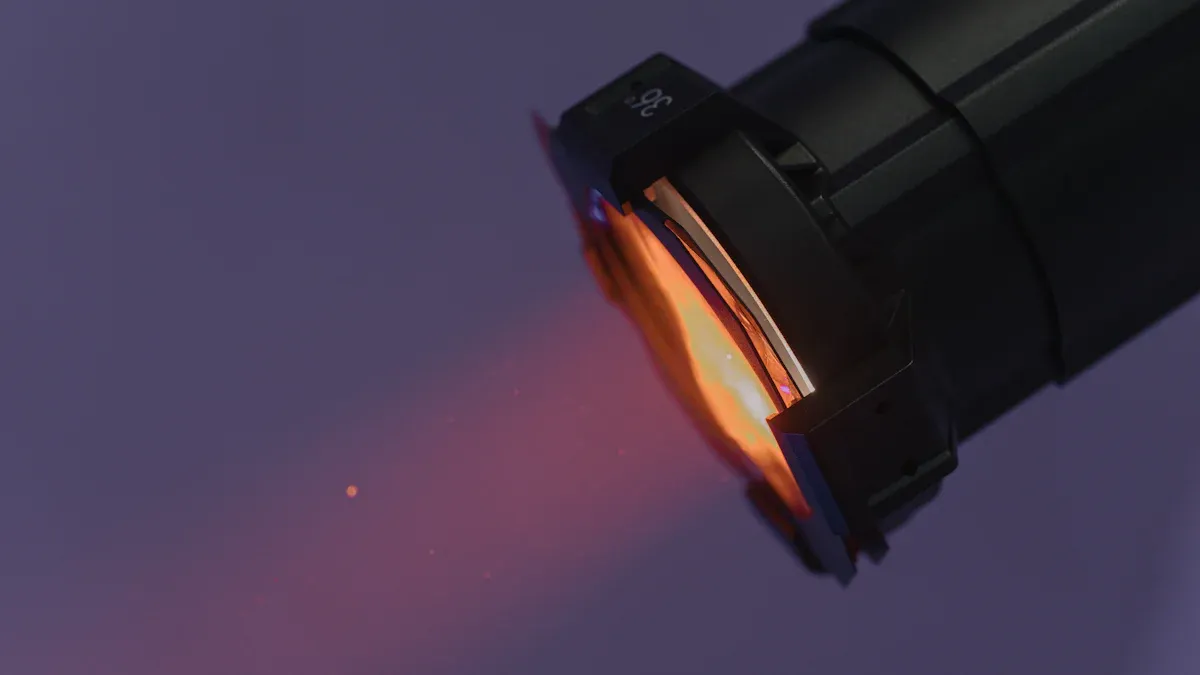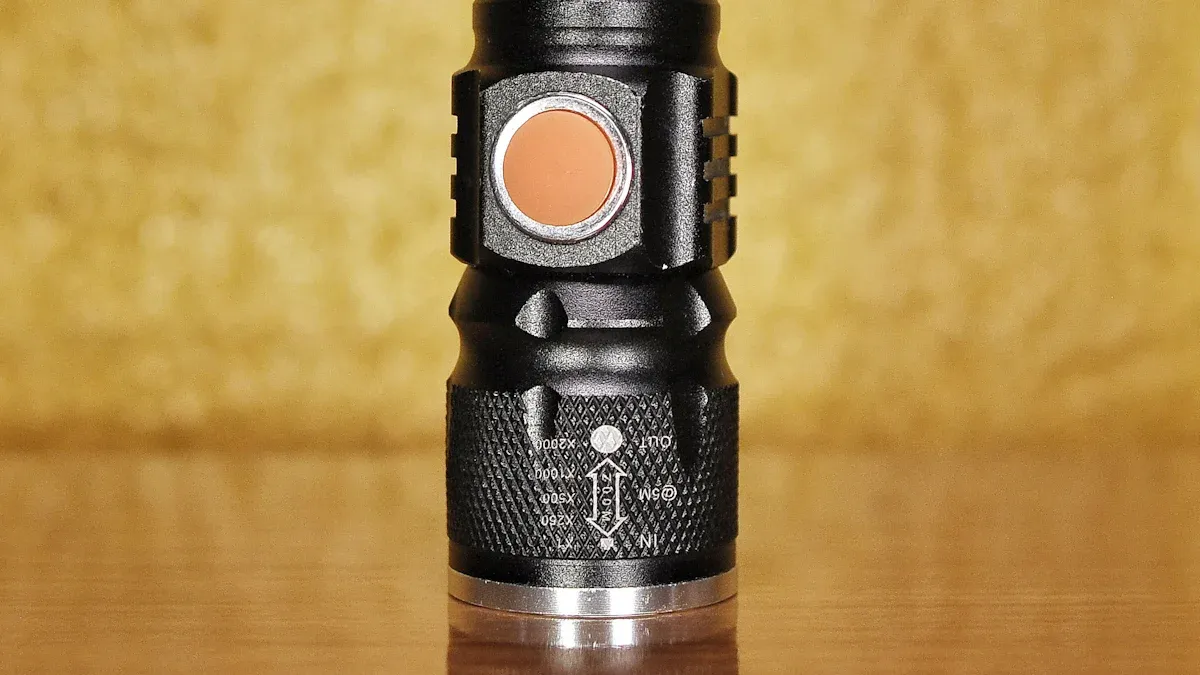How Flashlights Can Improve Safety During Natural Disasters

During natural disasters, darkness can create dangerous situations. Flashlights provide critical illumination, ensuring you can see and navigate safely. Their life-saving power of flashlights lies in their ability to improve safety by offering light during power outages, helping you avoid hazards, and signaling for help. As an essential item, they have saved lives in emergencies, such as hikers signaling rescue helicopters or motorists stranded at night. Flashlights are indispensable tools for disaster preparedness.
Key Takeaways
Flashlights give light during blackouts, helping you move safely.
Pick a strong, waterproof flashlight with lasting batteries for emergencies.
Check your flashlight often to make sure it works well.
How Flashlights Improve Safety During Natural Disasters

Providing Light During Power Outages
During disasters, power outages are common and can leave you in complete darkness. A flashlight provides reliable illumination, ensuring you can navigate safely through your surroundings. It helps you locate essential items, such as first aid supplies or food, without fumbling in the dark. Flashlights also reduce the risk of accidents by illuminating obstacles like debris or uneven surfaces. In workplaces, they guide employees to safety during evacuations, ensuring visibility in dark areas. A good emergency kit always includes a flashlight to maximize safety during power outages.
Aiding Navigation and Avoiding Hazards
Flashlights improve safety by helping you navigate through hazardous environments. Whether you are moving through a damaged building or walking outdoors during a storm, a flashlight ensures you can see potential dangers. Reliable illumination allows you to avoid sharp objects, broken glass, or unstable structures. A portable flashlight is especially useful for maintaining mobility in such situations. Its portability ensures you can carry it easily while focusing on your path.
Signaling for Help in Emergencies
In emergencies, a flashlight becomes a vital signaling tool. You can use it to attract attention by flashing it repeatedly or pointing it toward rescuers. This method is especially effective at night or in low-visibility conditions. A reliable light source can mean the difference between being found quickly or waiting longer for help. Many of the best flashlights come with strobe or SOS modes, designed specifically for signaling during disasters.
Preventing Fire Hazards Compared to Candles
Candles may seem like an alternative during power outages, but they pose significant fire risks. A flashlight offers a safer option, providing reliable illumination without the danger of open flames. You can use it for extended periods without worrying about accidents. This makes flashlights a better choice for maximizing safety, especially in environments with flammable materials. Including a flashlight in your emergency kit ensures you have a dependable and safe light source during disasters.
Choosing the Right Flashlight for Emergencies

Key Features: Brightness, Battery Life, and Durability
When selecting a flashlight for emergencies, focus on key features that ensure its effectiveness. Brightness, measured in lumens, determines how well you can see in dark or low-visibility conditions. For indoor use, aim for at least 200-300 lumens, while outdoor scenarios may require higher brightness levels. Battery life is equally important. A flashlight with long-lasting batteries or multiple power modes ensures it remains functional during extended emergencies. Durability is another critical factor. Look for models made from impact-resistant materials to withstand drops or rough handling.
Tip: Compact and lightweight flashlights are easier to carry and store, making them ideal for emergency kits.
Importance of Water Resistance and Weatherproofing
A water-resistant flashlight offers unmatched reliability during natural disasters. These flashlights are designed to function in heavy rain, storms, or even after accidental submersion in water. They prevent moisture from damaging internal components, ensuring consistent performance when you need it most. Weatherproofing adds another layer of protection, allowing the flashlight to endure extreme conditions like high winds or freezing temperatures. Choosing a flashlight with a good IP rating guarantees it will remain operational in unpredictable environments.
Types of Flashlights: Handheld, Headlamps, and Lanterns
Different types of flashlights serve various purposes during emergencies. Handheld flashlights are versatile and easy to use, making them a popular choice for general tasks. Headlamps provide hands-free illumination, which is especially useful when navigating or performing tasks in the dark. Lanterns, on the other hand, offer broader light coverage, ideal for lighting up larger spaces like rooms or campsites. Each type has its advantages, so consider your specific needs when choosing the right flashlight for your emergency kit.
Maintaining Flashlights for Emergency Preparedness
Regular Battery Checks and Replacements
Keeping your flashlight ready for emergencies requires regular battery maintenance. Check the battery levels monthly to ensure they are fully charged or replace them if necessary. For rechargeable flashlights, establish a routine to charge them fully at least once a month. If your flashlight uses non-rechargeable batteries, replace them periodically to avoid dimming performance during critical moments. Removing batteries during long-term storage prevents leakage and corrosion, which can damage the flashlight. Always keep spare batteries in your emergency kit to ensure uninterrupted functionality when you need it most.
Proper Cleaning and Storage
Proper cleaning and storage extend the lifespan of your flashlight and ensure it performs reliably during emergencies. Wipe the exterior with a dry or slightly damp cloth to remove dirt and grime. Clean the lens with a soft, lint-free cloth to maintain optimal visibility without scratching the surface. Inspect and replace O-rings regularly to preserve waterproof capabilities. Before storing your flashlight, clean it thoroughly and remove the batteries. Store it in a cool, dry place away from temperature extremes to prevent corrosion. For high-end models, use a protective case to avoid physical damage.
Periodic Testing for Functionality
Testing your flashlight periodically ensures it remains operational during emergencies. Conduct monthly check-ups to inspect the battery contacts and test the switch and light modes. Every three to six months, perform a more thorough inspection to confirm all components are functioning correctly. Clean the electrical contacts with rubbing alcohol to remove any corrosion that may hinder performance. Regular testing not only guarantees functionality but also gives you peace of mind knowing your flashlight is ready to provide visibility when disaster strikes.
Tip: Add flashlight maintenance to your emergency preparedness kit checklist to stay organized and prepared.
Flashlights are essential tools for survival, offering unmatched utility during emergencies. They provide safety in darkness, helping you navigate hazardous areas and avoid unseen dangers. Their ability to signal for help can be life-saving when surviving a natural disaster. Including a reliable flashlight in your emergency kit ensures you are prepared for power outages and other challenges. By choosing a durable, multipurpose flashlight and maintaining it regularly, you can enhance your readiness for any disaster. The importance of flashlights in emergencies cannot be overstated—they are indispensable for safety and preparedness.
Tip: Add a flashlight with long battery life and weatherproofing to your emergency kit today.
FAQ
What type of flashlight is best for emergency preparedness?
Choose a durable, water-resistant flashlight with long battery life. Headlamps or lanterns are excellent for hands-free use or lighting larger areas during emergencies.
How often should you check your flashlight for emergency preparedness?
Test your flashlight monthly. Check batteries, clean the lens, and ensure all components function properly. Regular maintenance ensures reliability during emergencies.
Why is a flashlight essential for emergency preparedness?
A flashlight provides light during power outages, helps you navigate hazards, and signals for help. It’s a critical tool for staying safe in emergencies.
See Also
Why Rechargeable Flashlights Enhance Community Safety Efforts
A Homeowner's Guide to Selecting the Ideal Emergency Flashlight
Our Emergency Flashlight: Designed for Long-Lasting Durability
